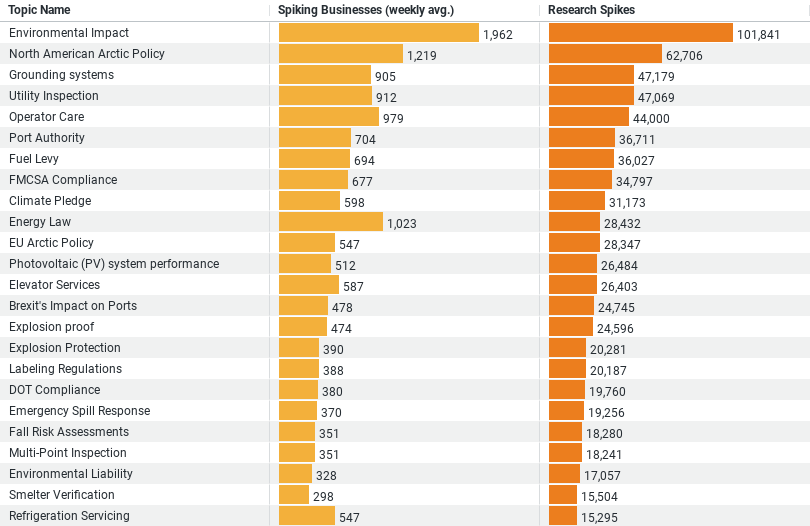Executive Summary: Standards & Regulatory Research Trends in the Construction Industry
1. Environmental Impact is the top-researched topic, with a weekly average of 1,961.87 spiking businesses. This indicates a high level of interest and concern within the construction industry regarding environmental standards and regulations. The topic also has the highest number of research spikes, amounting to 101,841 instances. This could suggest a growing focus on sustainable construction practices and compliance with environmental regulations.
2. North American Arctic Policy follows as the second most-researched topic with 1,219.40 spiking businesses weekly on average and 62,706 research spikes. This might reflect the construction industry’s interest in the specific standards and regulations affecting Arctic development projects, including environmental protection, indigenous rights, and international cooperation in North American Arctic regions.
3. Grounding Systems and Utility Inspection are closely ranked, with weekly averages of 905.35 and 911.71 spiking businesses, respectively. Grounding systems, with 47,179 research spikes, and utility inspection, with 47,069 spikes, highlight the construction industry’s concern for electrical safety and utility standards, ensuring that projects comply with regulatory requirements for safety and functionality.
4. Operator Care is another significant area of research, with 979.4 spiking businesses weekly on average and 44,000 research spikes. This suggests an emphasis on the standards and regulations related to the care and management of construction machinery and equipment operators, focusing on safety, training, and certification standards.
These insights indicate a strong emphasis within the construction industry on compliance with environmental, safety, and operational standards and regulations. There’s a notable focus on sustainable construction practices, safety measures, and adherence to policies affecting specific regions or aspects of construction projects.
Construction Industry Focus: Standards & Regulatory Insights
The construction sector is undergoing a transformative phase, increasingly gravitating towards the integration of standards and regulatory considerations into its core operational strategies. This shift is vividly reflected in the industry’s research trends, particularly concerning topics such as environmental impact, Arctic policy, grounding systems, utility inspection, and operator care. Through a detailed analysis of recent data, several key insights emerge, underlining the construction industry’s priorities and concerns within the ambit of Standards & Regulatory frameworks.
Environmental Impact: Leading the Charge
At the forefront of this research trend is the topic of “Environmental Impact,” with an impressive weekly average of 1,961.87 spiking businesses. This statistic not only underscores the sector’s acute awareness of its role in shaping sustainable futures but also reflects a collective endeavor to align with environmental standards and regulations. The overwhelming 101,841 research spikes in this area indicate a robust interest in adopting construction practices that mitigate environmental degradation while promoting sustainability. Such trends suggest the industry’s proactive stance in integrating green practices, from material selection to waste management and energy efficiency.
Safety Standards: Grounding Systems and Utility Inspection
The data also reveals a close contest between “Grounding Systems” and “Utility Inspection,” with weekly averages of 905.35 and 911.71 spiking businesses, respectively. These topics, with nearly identical research spikes, spotlight the industry’s vigilant approach to electrical safety and utility standards. Grounding systems are crucial for protecting projects from electrical hazards, while utility inspections ensure the reliability and safety of infrastructure. Such emphasis on safety standards underscores the sector’s commitment to preventing accidents, ensuring worker safety, and delivering projects that meet the highest quality and safety benchmarks.
Enhancing Operator Care
Moreover, the focus on “Operator Care,” with 979.4 spiking businesses weekly and 44,000 research spikes, signifies the industry’s dedication to the well-being and proficiency of machinery and equipment operators. This trend reflects the importance of stringent standards and regulations in safeguarding operators, enhancing their skills through training and certification, and ensuring the efficient and safe operation of construction equipment.
Implications and Future Directions
These insights illuminate the construction industry’s concerted efforts to navigate and adhere to a complex landscape of standards and regulatory requirements. The prioritization of environmental sustainability, safety, and operational efficiency is evident in the research trends, highlighting an industry in transition towards more responsible and compliant practices.
As the construction sector continues to evolve, these areas of interest are likely to shape future practices, guiding the industry towards innovations that not only enhance project outcomes but also contribute positively to societal and environmental well-being. The focus on regulatory compliance and standards is a clear indicator of the industry’s commitment to excellence, safety, and sustainability.
In conclusion, the construction industry’s research trends offer a window into its current priorities and concerns, with a strong emphasis on Standards & Regulatory considerations. By aligning operations with these frameworks, the sector not only ensures compliance but also champions the principles of sustainability and safety. As research continues to guide industry practices, the construction sector is well-positioned to address the challenges of the modern world, delivering projects that stand as testaments to quality, resilience, and responsible development.
Company Sample Data
### Company Sample Data: Trends by Company Size
– Micro (1 – 9 Employees): This category has 958.46 average weekly spiking businesses, accounting for approximately 9.86% of the total. This indicates that even the smallest companies are actively engaged in staying informed and perhaps agile enough to pivot or integrate new trends and standards into their operations. Their active engagement suggests a trend where smaller businesses are keen on leveraging knowledge to remain competitive.
– Small (10 – 49 Employees): Small businesses show a significant increase in engagement, with 2,674.88 spiking businesses on average weekly, making up 27.50% of the total. This uptick suggests that as companies grow, their capacity and need to engage with industry trends, standards, and regulatory information expand. This group’s substantial engagement highlights the importance of strategic planning and compliance as businesses scale.
– Medium-Small (50 – 199 Employees): With the highest engagement of 3,035.42 weekly spiking businesses and constituting 31.21% of the total, medium-small businesses appear to be the most active in researching and possibly implementing new standards or regulations. This could be due to these companies having more resources to dedicate to compliance and innovation, along with a greater need to mitigate risks as they deal with more complex projects or enter new markets.
– Medium (200 – 499 Employees): Engagement dips to 1,423.15 spiking businesses weekly, representing 14.63% of the total. This decrease might reflect the challenges of coordinating and implementing new initiatives across a larger organization. However, the substantial engagement still underscores a strong intent to comply with industry standards and leverage new trends for growth and efficiency.
– Medium-Large (500 – 999 Employees): The data shows a further decline in engagement, with 681.58 weekly spiking businesses, which is 7.01% of the total. As companies grow, the agility to adopt new trends may diminish, but the continued engagement reflects an ongoing commitment to compliance and the pursuit of opportunities for improvement and innovation.
Why This Is a Trend
The dataset reveals a compelling trend: the level of engagement with new trends, standards, and regulatory compliance information appears to be closely related to company size. Smaller companies show robust engagement, likely driven by their need to remain competitive and agile. As companies grow, the engagement initially increases, suggesting an expanding capacity and need for compliance and strategic integration of new information.
However, at larger scales, while the absolute number of engaged businesses decreases, the continued involvement underscores a sustained commitment to staying informed and compliant. This trend highlights the balance between agility and the complexities of scaling compliance and innovation efforts across larger organizational structures.
In summary, the dataset illustrates a nuanced picture of how companies of various sizes engage with industry trends and regulatory information. It underscores the dynamic interplay between company size, capacity for innovation, and commitment to compliance, reflecting broader trends in the business ecosystem’s adaptive and strategic behaviors.



